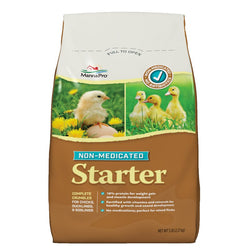All about Domestic Newcastle disease
Back to blog
Domestic Newcastle
Also called
Newcastle Disease, Avian Distemper, Pseudofowl, ND, Parainfluenza, Fake Flu
Prevalence
Common
Signs
General signs -
Coughing, sneezing, wheezing, lack of appetite, lethargy, huddling near heat source and fluffed-up down. Mucousy nares (nostrils). Occasionally layers exhibit a drop in laying and misshapen eggs. Some birds show signs of neurological disorders about two weeks after the respiratory illness. Mortality is low in backyard flocks with an owner who can isolate a bird until recovery. In large commercial flocks without close supervision, birds showing neurological symptoms can get picked to death.
Cardinal or diagnostic signs -
Lab ID, or can be diagnosed by a vet in birds showing both respiratory and neurological symptoms.
Cause/s
Paramyxovirus
Communicability
Quite contagious. Since the virus can affect wild birds, it may be brought into a pasture-raised flock fairly easily, even if management is good.
Communicability to humans
Humans can get a mild conjunctival (eye) infection from sick birds, or from mishandling the vaccine.
Incubation period
48 hours to 15 days
Latent
Yes. Chickens can be asymptomatic carriers for about a month after recovery.
Endemic
Yes. It can be carried by wild birds, and is fairly common throughout the world.
Home treatment and/or prevention
Prevention: Difficult. Because it can be carried by wild birds and brought in on shoes or equipment, you can really pick it up almost anywhere. There are vaccines for ND, but they are relatively short-term and require repeated boosters, so it's not common to vaccinate in a backyard flock.
Treatment: None. Keep infected birds free of stressors; watch for concurrent infections. Take care to monitor birds showing neurological symptoms; when they can't move well, they can be targets for pecking, and can get picked-on to death.
Veterinary care
None. However, a vet can diagnose the illness for sure (some respiratory ailments are far more serious), and may be able to provide treatment for any concurrent infections.
Recovery
About a week. When neurological symptoms occur, recovery can take three weeks or so.
Other conditions, illnesses and/or diseases with similar signs:
Can be mistaken for Infectious Bronchitis and other respiratory ailments. Occasionally the neurological issues are mistaken for Mareks or Lymphoid Leucosis (when one leg seems lame).
Also consider browsing through this list of other chicken illnesses with respiratory symptoms, or this list of chicken illnesses with neurological symptoms.
Newcastle Disease, Avian Distemper, Pseudofowl, ND, Parainfluenza, Fake Flu
Prevalence
Common
Signs
General signs -
Coughing, sneezing, wheezing, lack of appetite, lethargy, huddling near heat source and fluffed-up down. Mucousy nares (nostrils). Occasionally layers exhibit a drop in laying and misshapen eggs. Some birds show signs of neurological disorders about two weeks after the respiratory illness. Mortality is low in backyard flocks with an owner who can isolate a bird until recovery. In large commercial flocks without close supervision, birds showing neurological symptoms can get picked to death.
Cardinal or diagnostic signs -
Lab ID, or can be diagnosed by a vet in birds showing both respiratory and neurological symptoms.
Cause/s
Paramyxovirus
Communicability
Quite contagious. Since the virus can affect wild birds, it may be brought into a pasture-raised flock fairly easily, even if management is good.
Communicability to humans
Humans can get a mild conjunctival (eye) infection from sick birds, or from mishandling the vaccine.
Incubation period
48 hours to 15 days
Latent
Yes. Chickens can be asymptomatic carriers for about a month after recovery.
Endemic
Yes. It can be carried by wild birds, and is fairly common throughout the world.
Home treatment and/or prevention
Prevention: Difficult. Because it can be carried by wild birds and brought in on shoes or equipment, you can really pick it up almost anywhere. There are vaccines for ND, but they are relatively short-term and require repeated boosters, so it's not common to vaccinate in a backyard flock.
Treatment: None. Keep infected birds free of stressors; watch for concurrent infections. Take care to monitor birds showing neurological symptoms; when they can't move well, they can be targets for pecking, and can get picked-on to death.
Veterinary care
None. However, a vet can diagnose the illness for sure (some respiratory ailments are far more serious), and may be able to provide treatment for any concurrent infections.
Recovery
About a week. When neurological symptoms occur, recovery can take three weeks or so.
Other conditions, illnesses and/or diseases with similar signs:
Can be mistaken for Infectious Bronchitis and other respiratory ailments. Occasionally the neurological issues are mistaken for Mareks or Lymphoid Leucosis (when one leg seems lame).
Also consider browsing through this list of other chicken illnesses with respiratory symptoms, or this list of chicken illnesses with neurological symptoms.











